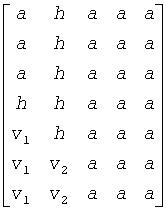Developer Reference for Intel® oneAPI Math Kernel Library for Fortran
A newer version of this document is available. Customers should click here to go to the newest version.
?lahrd
Reduces the first nb columns of a general rectangular matrix A so that elements below the k-th subdiagonal are zero, and returns auxiliary matrices which are needed to apply the transformation to the unreduced part of A (deprecated).
call slahrd( n, k, nb, a, lda, tau, t, ldt, y, ldy )
call dlahrd( n, k, nb, a, lda, tau, t, ldt, y, ldy )
call clahrd( n, k, nb, a, lda, tau, t, ldt, y, ldy )
call zlahrd( n, k, nb, a, lda, tau, t, ldt, y, ldy )
- mkl.fi
This routine is deprecated; use lahr2.
The routine reduces the first nb columns of a real/complex general n-by-(n-k+1) matrix A so that elements below the k-th subdiagonal are zero. The reduction is performed by an orthogonal/unitary similarity transformation QT*A*Q for real flavors, or QH*A*Q for complex flavors. The routine returns the matrices V and T which determine Q as a block reflector I - V*T*VT (for real flavors) or I - V*T*VH (for complex flavors), and also the matrix Y = A*V*T.
The matrix Q is represented as products of nb elementary reflectors:
Q = H(1)*H(2)*... *H(nb)
Each H(i) has the form
H(i) = I - tau*v*vT for real flavors, or
H(i) = I - tau*v*vH for complex flavors, or
where tau is a real/complex scalar, and v is a real/complex vector.
- n
-
INTEGER. The order of the matrix A (n≥ 0).
- k
-
INTEGER. The offset for the reduction. Elements below the k-th subdiagonal in the first nb columns are reduced to zero.
- nb
-
INTEGER. The number of columns to be reduced.
- a
-
REAL for slahrd
DOUBLE PRECISION for dlahrd
COMPLEX for clahrd
DOUBLE COMPLEX for zlahrd.
Array a(lda, n-k+1) contains the n-by-(n-k+1) general matrix A to be reduced.
- lda
-
INTEGER. The leading dimension of a; at least max(1, n).
- ldt
-
INTEGER. The leading dimension of the output array t; must be at least max(1, nb).
- ldy
-
INTEGER. The leading dimension of the output array y; must be at least max(1, n).
- a
-
On exit, the elements on and above the k-th subdiagonal in the first nb columns are overwritten with the corresponding elements of the reduced matrix; the elements below the k-th subdiagonal, with the array tau, represent the matrix Q as a product of elementary reflectors. The other columns of a are unchanged. See Application Notes below.
- tau
-
REAL for slahrd
DOUBLE PRECISION for dlahrd
COMPLEX for clahrd
DOUBLE COMPLEX for zlahrd.
Array, DIMENSION (nb).
Contains scalar factors of the elementary reflectors.
- t, y
-
REAL for slahrd
DOUBLE PRECISION for dlahrd
COMPLEX for clahrd
DOUBLE COMPLEX for zlahrd.
Arrays, dimension t(ldt, nb), y(ldy, nb).
The array t contains upper triangular matrix T.
The array y contains the n-by-nb matrix Y .
For the elementary reflector H(i),
v(1:i+k-1) = 0, v(i+k) = 1; v(i+k+1:n) is stored on exit in a(i+k+1:n, i) and tau is stored in tau(i).
The elements of the vectors v together form the (n-k+1)-by-nb matrix V which is needed, with T and Y, to apply the transformation to the unreduced part of the matrix, using an update of the form:
A := (I - V*T*VT) * (A - Y*VT) for real flavors, or
A := (I - V*T*VH) * (A - Y*VH) for complex flavors.
The contents of A on exit are illustrated by the following example with n = 7, k = 3 and nb = 2:

where a denotes an element of the original matrix A, h denotes a modified element of the upper Hessenberg matrix H, and vi denotes an element of the vector defining H(i).